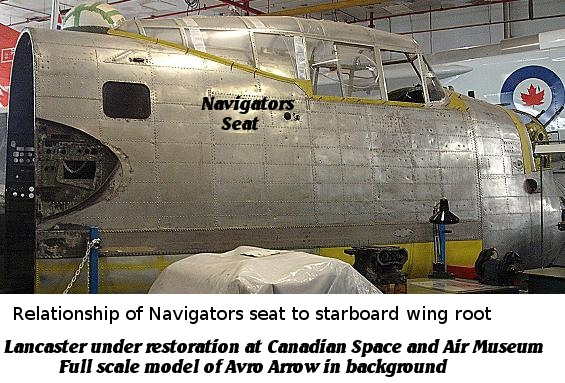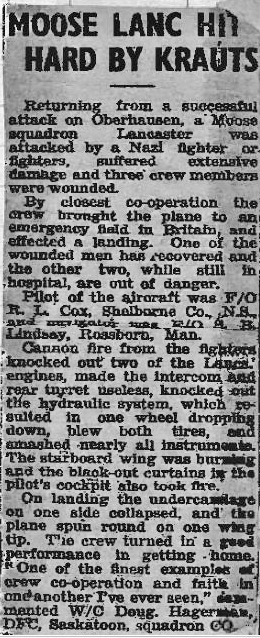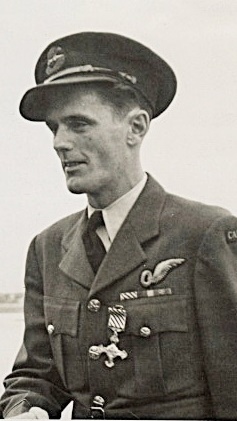Operations Begin
The crew did not have to wait long and by Mid-September they gathered at the Dispersal area of their charge for
the night VR-Z, the famous "Ruhr Express" the first Canadian made Lancaster. The operation was a diversion, the main
force of almost 500 aircraft was headed for Kiel. The diversion itself was not a small operation without it's dangers.
Over 160 bombers of all types were involved and five aircraft were lost by Bomber Command on this diversionary operation.
Navigator Lindsay's first accredited operation was on September 25th on Calais, he his crew would continue on
for ten more operations into Germany hitting the Krupps Works and Marshalling yards deep in the heavily
defended industrial sections. Flak and night fighters protected these areas heavily so the notation, "moderate flak"
can be miss-leading.
On the October 19th operation to Stuttgart, their Lancaster VR-Q received flak damage to the propeller
of one of the starboard engines. The propeller damage was not the only situation the crew faced,
there was the added danger of flying at a reduced speed while the bomb bay doors were open from at least one bomb
hung up in the rack. After finally managing to safely jettison it they headed for RAF Stradishall.
November 1st -Oberhausen - Loss of VR-U
As recorded in F/O Lindsay's logbook
"X" -Oberhausen - 1 x 4000 14 cluster Built-Up Area-Large Fires
Attacked By 2 Fighters:
Wounded in face- WAG and R/G. Wounded - Crash Landed Manston- Old "U"
A Total Wreck
Flak Moderate-Pilot and WAG Received D.F.C. - R.G -D.F.M.
Details from Combat Reports, Paint a Different Picture
Lindsay's Logbook seems a
simple straight forward record of what he thought was important points to
be on record. It reflects how these young airmen looked at their duties. They all faced the same dangers, just straight forward facts were needed to be recorded.
For the full view of the events that occurred on KB767 on the return from their target for the night, requires
a gathering of the information that was recorded within days of the attack on VR-U. These bits of information
found in the Combat Reports filed by F/S Toane and Sgt. Wilkins shortly after the well controlled crash landing
of their Lancaster. And within the comments sections of the citations given to the men, as well as other sources combine to give the following fuller picture of what happened.
As F/O Lindsay and fellow crewmen were leaving the target area in the cloud shrouded full moon above their port side,
fighter flares dropped past them on the starboard quarter.
Nothing happened for the next three minutes, then another air flare dropped past the starboard side of the aircraft and again
nothing happened for the next two minutes as Cox continued on at 15,000 feet on a course of 230 degrees true.
At approximately 2042 hours the enemy aircraft's tracer rounds came out of the starboard quarter down. Coming in out of the dark side of the sky closing in to 150 yards before opening fire then breaking off the attack at just 100 yards out. The rear gunner Sgt. Toane returned fire but only managed to expend 50 rounds as blood blinded his vision and from pain from wounds to his arms and leg.
F/O Cox executed a corkscrew to starboard as he sighted the tracer shells passing from the Lancaster's starboard side from the FW190. The manoeuvre was too late, the enemy had surprised the Lancaster and as it riddled the fuselage a cannon shell exploded inside the cramped fuselage.
The force of the blast threw the upper gunner Sgt. Wilkins out of his gunners seat unijured on to the floor of the fuselage.
F/O Lindsay was hit in the back and face by shrapnel flying in all directions. Fires broke out in front and behind him. Although injured he successfully extinguished the fire in front of him. F/O Sitlington who sat almost facing Lindsay in the Wireless section was wounded in the face and sustained wounds to his arm. He also had fires breaking out in his equipment and possibly from the flammable charts and rice paper flimsies on the navigators table adding to the blaze.
As Observer Lindsay under the stress of being wounded and in the shattered
conditions of the aircraft around him worked at putting out his second fire. This one in the starboard wing root. During these battles with the fires he had received burns to his hand(s). Duing this time as fires were being fought the Lancaster was
in a downward spiral throwing this small world
of the mid-section of the aircraft into a darkened nightmare lit only by the glare of the fires around him.

The inside the aircraft was in a bad way, the smoke and smells of burnt equipment, blood, broken glass and
debris everywhere. They had lost the intercom throughout the aircraft, the hydraulic system was lost, wireless
set was damaged, H2S radar shot up, both turrets were unable to rotate, leaving the crew sitting ducks
for any further attacks.
Things on the outside were not much better the starboard elevators in the tail section were shot away, the two
inside engines had to be feathered. One of these, the port inner provided power to some of the instruments, which now made them useless.
It is not to clear whether it was the same FW190 that again attacked them or a second enemy aircraft. But they
were again hit by the enemy fire and more damage occurred as on the fires were being worked on. F/O Cox managed to
level off the Lancaster and apparently loosing the attacker with those moves. But also much needed height was lost.
They were left with two engines to get them from somewhere west of
Oberhausen back to Britain. And they could not fly back in just a straight line to the Channel, they had
to thread their way back avoiding heavily defended areas with their flak and search light defences.
The task was up to Lindsay, wounded, drained by the shock and effects felt after an adrenaline rush,
working with few instruments, for even the DR compass, ( which was a repeater type device that both
the pilot and navigator had in front of them. The compasses were connected together so both showed the exact
direction of travel ) had also been shot up. Only by checking and rechecking a secondary compass and passing by shouting to Cox over roar of the two remaining engines did they keep on course. They made there way
across Germany, the Lowland countries and past the coast and out towards the sea trying to reach England.
During this time from Gremany to over the sea the Lancaster had spiralled down and lost height twice. It may have been while heading out past the coast of Belgian Cox the Captain decided to turn back for the beaches on the coast. Thinking the crew especially the wounded would have a better chance of surviving a landing on a beach than into the cold winter waters of the sea. There is no timeline as to when he made this decision.
As they headed back to the Belgium, Sgt. Dennis had managed to restart the port inner engine giving them more power as well as bring a portion of the instruments back to life. With the three engines running a choice was to make a turn to bring VR-U "Uncle" again in the direction of England. Lindsay then charted a new heading.
Even with RAF Manston in view the journey wasn't over yet, the hydraulics were not working, one wheel had already dropped down because of the
loss of the hydraulic system. And it mattered little since both tires had been hit and were now deflated.
It was going to be a crash landing as they approached the unfamiliar layout of RAF Manston.
KB767 VR-U made the landing without further injuries to the crew. The wounded men were on their way to medical help,
Sitlington and Toane were rushed to Halton P.M. hospital while F/O Lindsay was taken to the Base hospital
In the end VR-U was a wreck but she and her crew had pulled together and brought them home.
Documents show it was not until the next day that Cox called Middleton St. George to let them know the condition of the crew and that VR-U was a write off. The document must have referred to KB767 having made it to Manston in the early morning hours after the attacks which had begun at 2042 the night before.
F/O Lindsay's DFC Citation
This officer was the navigator in an aircraft which attacked Oberhausen.
Shortly after leaving the target the aircraft was attacked by a fighter.
Extensive damage was sustained. Three of the crew were wounded including
Flying Officer Lindsay who was hit in the back; his face was also badly
lacerated by fragments of shrapnel. A fire had started in the compartment
but he was able to quell it by means of an extinguisher. He afterwards
put out another fire which had started in the root of the starboard wing.
In so doing his hands were badly burned. Soon afterwards Flying Officer
Lindsay fainted through shock. He soon revived when his injuries
had been attended to and resumed his duties. Much of his equipment
had been destroyed in the fight. Nevertheless, he navigated the
aircraft to base. In the face of most harassing circumstances
this officer displayed great courage, fortitude and resource.
In addition to F/O Lindsay being awarded the DFC F/O Sitlington and F/O Cox also were
listed in documents as being presented with the DFC. Sgt. Toane and Sgt. Dennis received the DFM for their actions on that night
First Newspaper Clipping
TEAM WORK
WOUNDED CREW GOT PLANE BACK
'With the R.C.A.F. Bomber Group in Britain, Jan 12- (CP)
Despite wounds and a severely-damaged aircraft, the crew of the big Lancaster bomber managed to fly back to safety,
and the squadron C.O. later termed it "one of the finest examples of crew co-operation and faith in one another
I've ever seen".
The Canadian built aircraft, operating out of the Moose squadron, was on it's way home from a successful attack
on Oberhausen when cannon shells riddled the plane.
The rear gunner and the wireless operator were wounded, while the Navigator FO S.B. Lindsay, of Rossburn Man.
suffered superficial injuries in putting out the fire in the starboard wing.
Two of the Lanc's four engines were knocked out, one on each wing. The knocked out hydraulic system permitted
one wheel to hang down. Both tires were blown out and almost all the instruments smashed.
The starboard wing was burning and one cannon shell pierced the bomb bay but failed to explode.
One explosion blew the mid-upper gunner out of his turret down to the fuselage corridor without hurting him.
Lindsay fainted after fighting the fire, but on reviving returned to his duties and guided the aircraft to an
emergency aerodrome near the British coast despite the conditions he had to work almost without instruments."
A Second Clipping
Headline reads: MOOSE LANC HIT HARD BY KRAUTS

"Returning from a successful
attack on Oberhausen a Moose squadron Lancaster was attacked by a Nazi fighter or two fighters, suffered extensive
damage and three crew members were wounded.
By the closest co-operation the crew brought the plane to an emergency field in Britain and affected a landing. One
of the wounded men has recovered and the other two, while still in hospital, are out of danger.
Pilot of the aircraft was F/O R.L. Cox, Shelbourne Co. N.S. and Navigator was F/O S.B. Lindsay of Rossburn Man.
Cannon fire from the fighters knocked out two the Lancaster's engines, made the intercom and rear turret useless,
knocked out the hydraulic system, which resulted in one wheel dropping down, blew both tires, and smashed nearly
all the instruments. The starboard wing was burning and the black out curtains in the pilot's cockpit also took
fire.
On Landing the undercarriage on one side collapsed and he plane spun round on one wing tip. The crew turned in
a good performance in getting home.
"One of the finest examples of crew co-operation and faith in one another I've ever seen." commented W/C Doug.
Hagersman, DFC, Saskatoon, squadron CO."
Return to Operations
Before returning to the squadron for active duties F/O Lindsay and F/O Cox completed some exercises in cross country trips flying in an Oxford.
On December 28th 1944, F/O Lindsay was reunited with F/O Cox, F/O Palanek
, Sgt. Dennis and Sgt. Wilkins on an operation to Oplanden.
New members of the crew were F/S Peter Weins rear gunner and F/O J.G. Gibbs Wireless
operator.
F/O Lindsay flew four more operations with F/O Cox and this crew.
On January 2nd. the third "reunion" operation the crew were flying VR-S "Sierra Sue"
when they were shot and hit at by Allied ground fire. ( They were not the only aircraft shot at.)
His last Operation with this crew was on the new VR-U, it was only fitting that it was aboard VR-U "Uncle" . It would not have been known to them at the time, but the crew would soon be dispersed to join other crews.
New Crews and Pilots
By the beginning of March F/O Lindsay was with a new captain F/O R. W. Millar and F/O Tony Palenek was still with Lindsay. The other crew members were new to both men. F/O Palenek would continue to be the Bomb Aimer on operations with Lindsay through to March 12th. When Lindsay and rear gunner P/O Peter Weins left the Millar crew.
Sadly one week later on March 21st. F/O Tony Palanek and F/O Robert Millar were killed when KB786 was brought down. It Was Millar's 35 sortie and would have been his last before completing his Tour.
Mid-April found F/O Lindsay as Navigator for F/O D.G. Dawson a captain with 22 operations completed.
With Dawson he would fly his final two wartime operations. As April saw the closing of the squadrons air offensives,
a new task was in the works for all the squadron.
Bringing VR-A Home to Canada
Of all the men on board the Lancaster's that were to cross the Atlantic, it would be the
Navigators that had the lives of the crew in their hands. Once they left the Azores and headed
for Newfoundland their high level of Navigation skills were essential in the safe arrival
of the crew and aircraft.
For many of the squadron's Navigators training on Astro Navigation would be new,
finding their way by H2S radar was no longer available. Learning to shoot the sun
was the only way home.
For F/O Lawson who had completed the Astro Navigation while he was being trained for coastal patrol so many months earlier, that training in Celestial Mechanics must have been great help. With Dawson at the controls KB841 VR-A landed back in Canada in June of 1945.
Preparations for Tiger Force
Mid-August of '45 was a time of more training, this time as part of the RCAF's
contribution to the war in the Pacific, Tiger Force.
More cross country flights on VR-A over the Nova Scotia area with Dawson flying until the squadron operations and training for Tiger Force were discontinued and in the following month the disbandment of the Moose squadron.
In all F/O Lindsay had flown over 362 hours during his service career.


